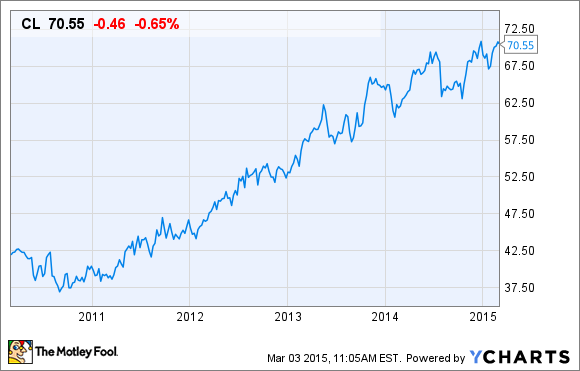Colgate-Palmolive Co. (CL 0.67%) is a beloved consumer staples company -- for good reason. With its high-quality brands, including its namesake toothpaste and hand soap, it has rewarded shareholders with rising profits and steady dividend payments for decades. The company has paid uninterrupted dividends on its common stock since 1895, an incredible streak that justifiably places Colgate-Palmolive in the good graces of income investors.
And the stock has kept on trucking, up 12% over the past year and now sitting close to all-time highs. Most recently, shares recently broke $70 per share on an analyst upgrade from the team at Citigroup. The consumer products giant is now a buy with a price target of $81 per share, up from a previous $74 target.
As you can see, Colgate-Palmolive has had a great run over the past five years. The new price target would represent additional 14% upside from the March 2nd closing price. But while it is easy to expect strong performance to continue, there are some red flags investors should consider before jumping in.
Valuation at a multi-year high
Strong business fundamentals are the main argument behind the Citigroup upgrade. In a note to clients, analysts said:
[After] hearing CEO Ian Cook speak at Consumer Analyst Group of New York (CAGNY) last week, we were reminded that while the global environment remains tough, both from a macroeconomic perspective and given stepped-up competition in some markets, Colgate-Palmolive generally manages through tough times well and usually emerges from them as a stronger player.
Additionally, the Citigroup analysts went on to say that even if Colgate-Palmolive simply met the low end of its guidance on revenue growth and margin expansion -- roughly 4% and 50 to 100 basis points, respectively -- this performance would place the company at the top of its peer group. While this may be entirely true, it does not address one glaring problem with buying the stock at its present level: valuation.
As previously mentioned, Colgate-Palmolive owns world-class brands and a leadership position in many markets, enriching investors. In fact, according to the company, Colgate-Palmolive stock delivered a 1,195% total return in the 20-year period from 1995 through 2014. This handily beat the 555% total return for the S&P 500 in the same period.
But it is also true that even great companies can amount to poor investments if too high a price is paid. Like it or not, Colgate-Palmolive holds a very rich valuation that makes its stock a riskier than meets the eye. The stock trades for 30 times trailing earnings and 21 times forward EPS estimates -- which handily exceed market multiples, and also its peer group.
CL P/E Ratio (TTM) data by YCharts
As you can see, the consumer staples sector as a whole appears aggressively valued. Sector leaders are trading above 25 times earnings, and Colgate-Palmolive leads the pack.
Over the past five years, Colgate-Palmolive returns have been generated mostly by multiple expansion, not earnings growth -- a dangerous scenario. Even if the company meets analyst estimates, it is not enough growth to justify the current valuation.
Slowing growth pokes holes in the bull case
Revenue growth at the company has also slowed considerably in recent years. Sales for 2014 were down slightly year-over-year, and earnings per share declined by the same amount. The year before, sales grew by just 2%. The weakness is partially due to the effects of currency fluctuations, a major headwind for many multinational companies at the moment, as the U.S. dollar continues to strengthen.
This slowdown has flowed through to the dividends. The company recently increased its payout by just 5.5%. That puts the company on track for its lowest annual payout increase in over a decade.
While Colgate-Palmolive is a highly profitable company with a long history of rewarding shareholders, the recent Citigroup upgrade seems to miss the bigger picture. Mid-single-digit revenue and earnings growth may not be enough to justify the lofty valuation. Because of this, investors may want to wait for a better buying opportunity before jumping in.







